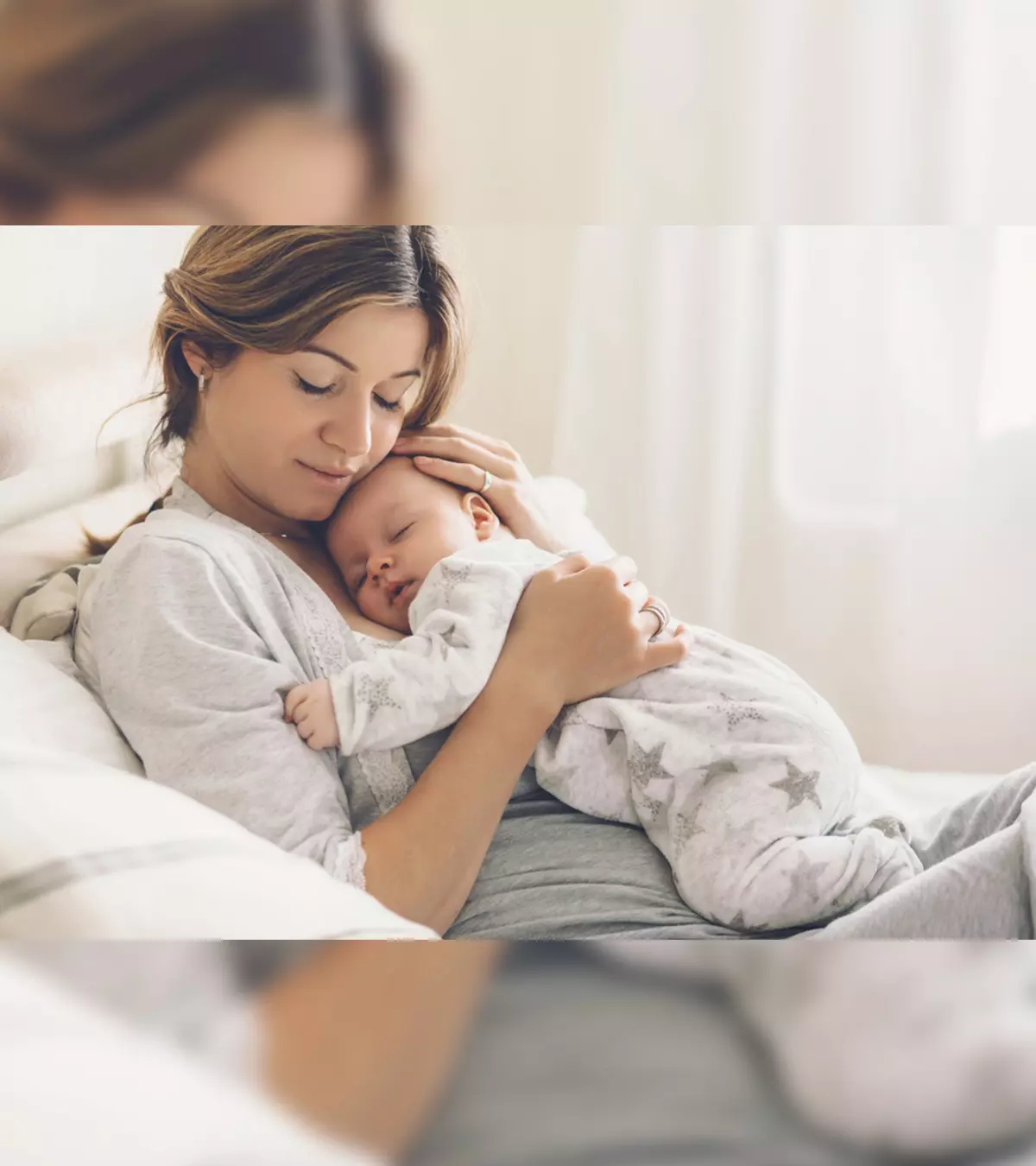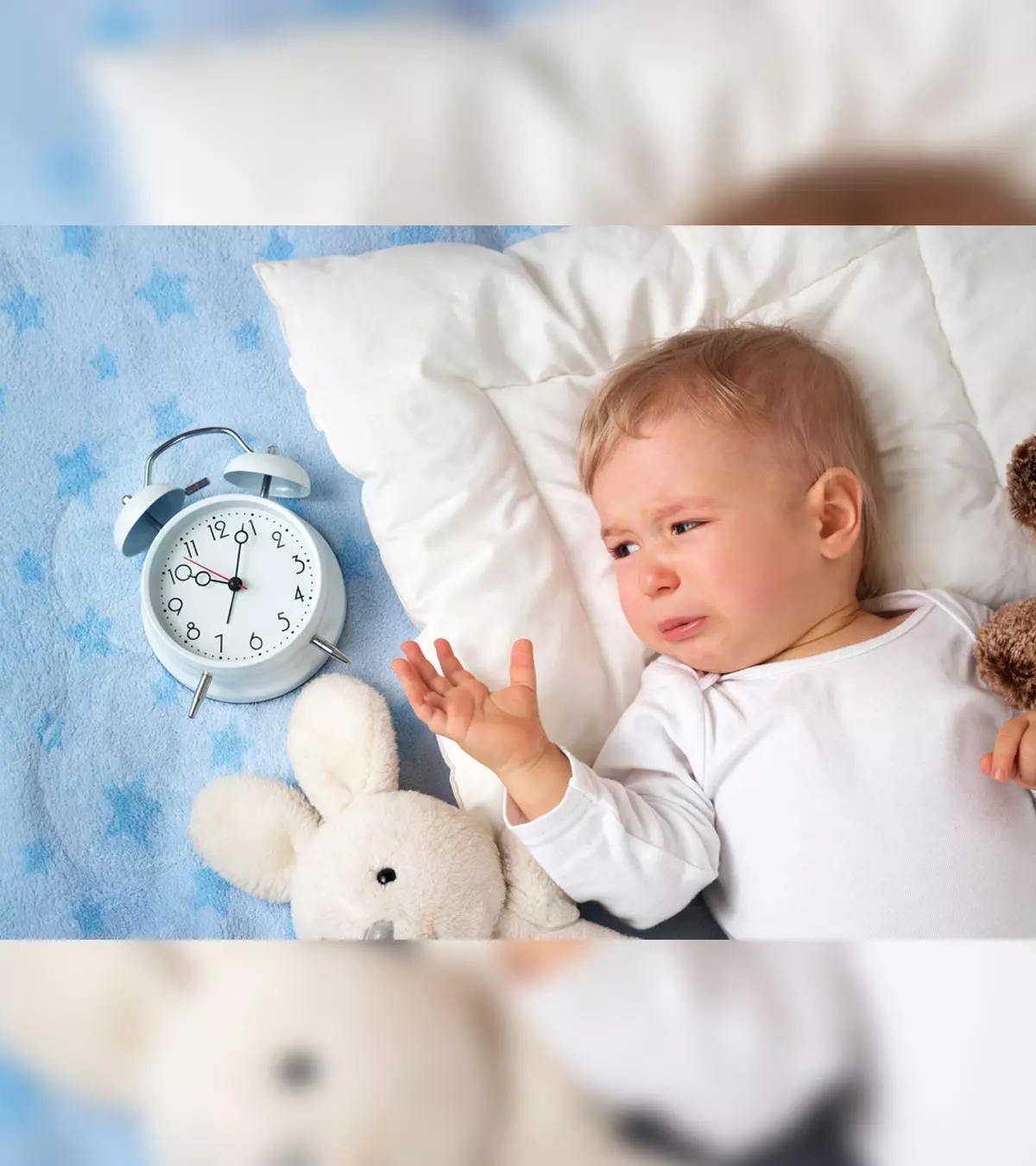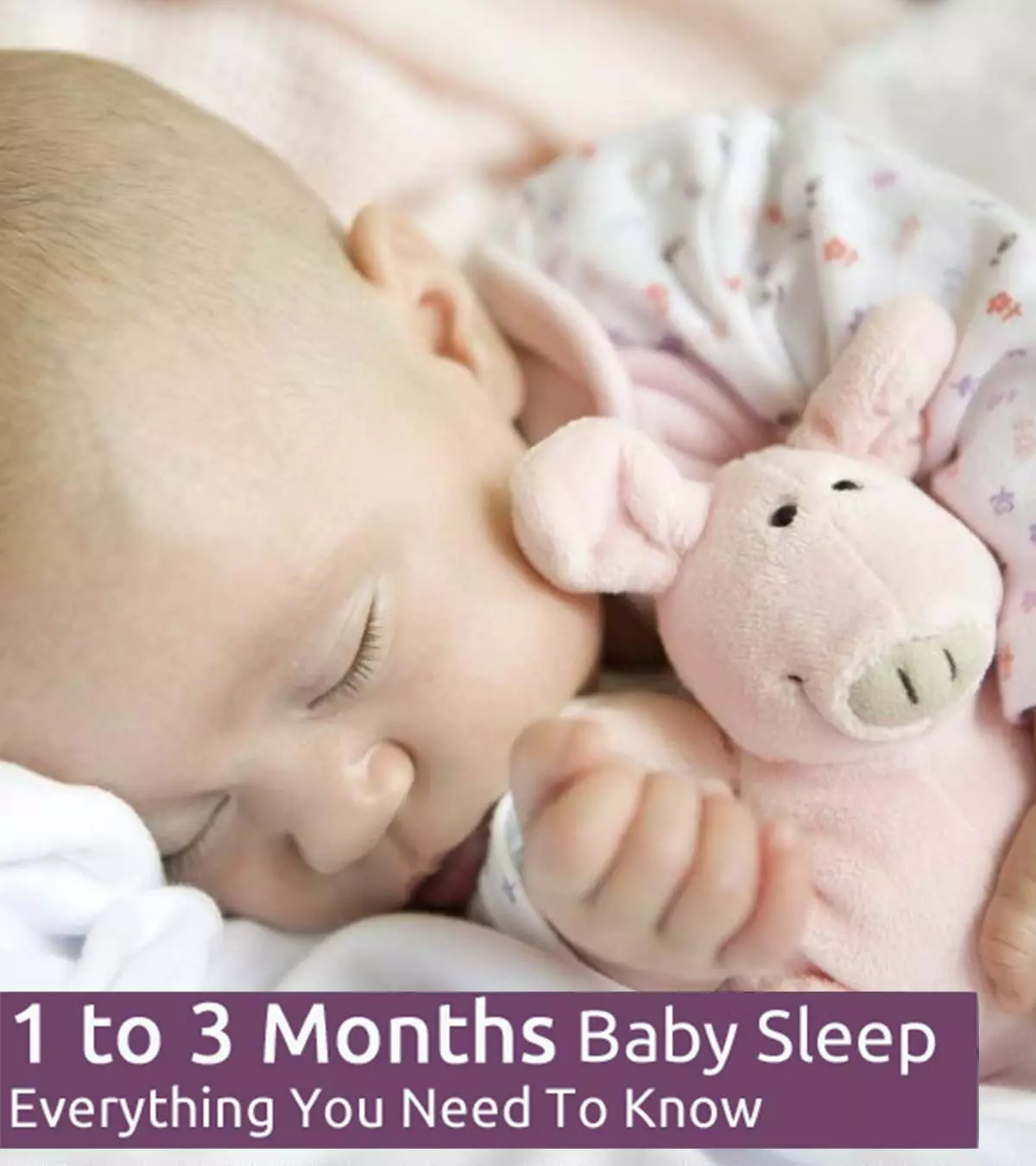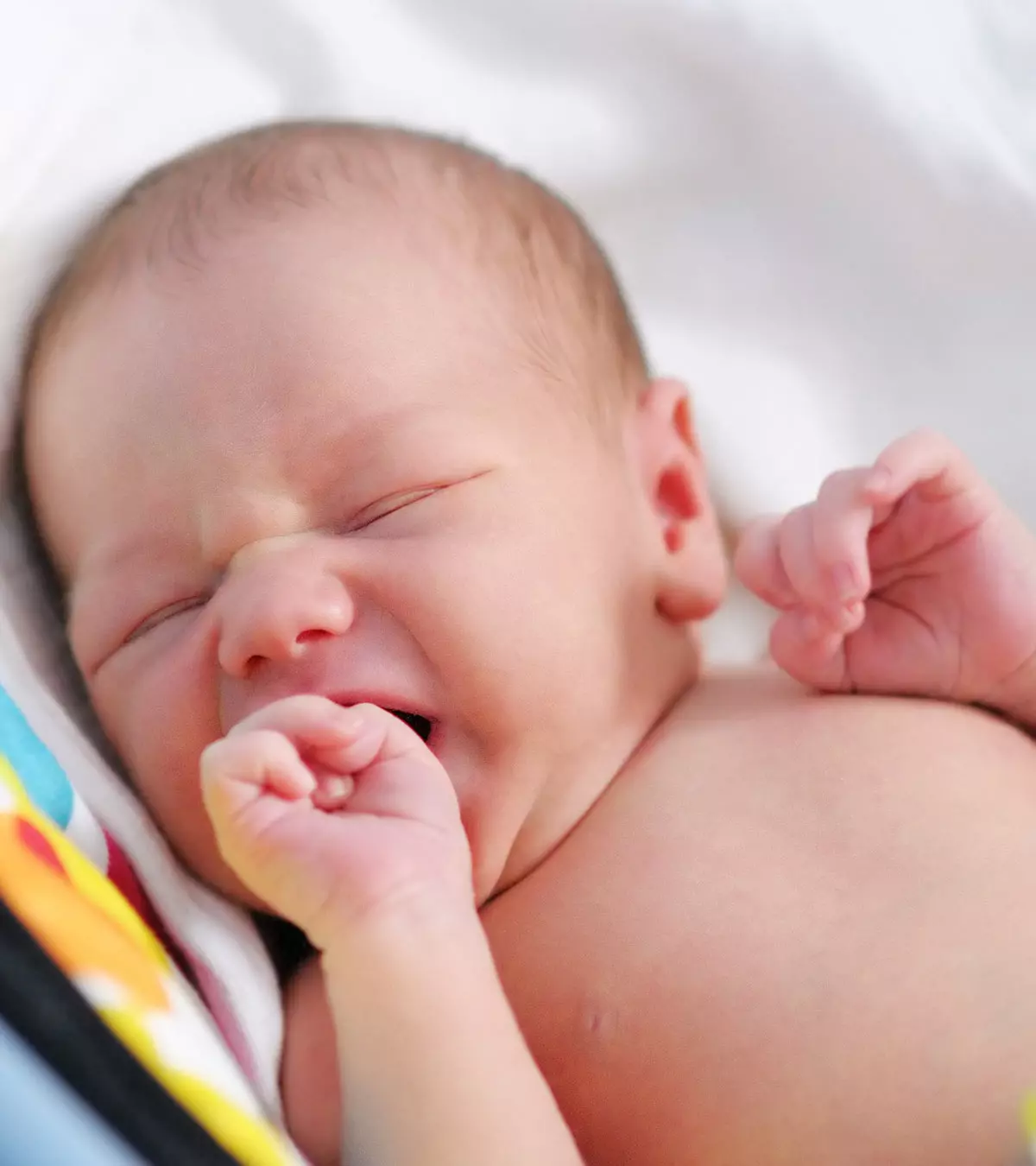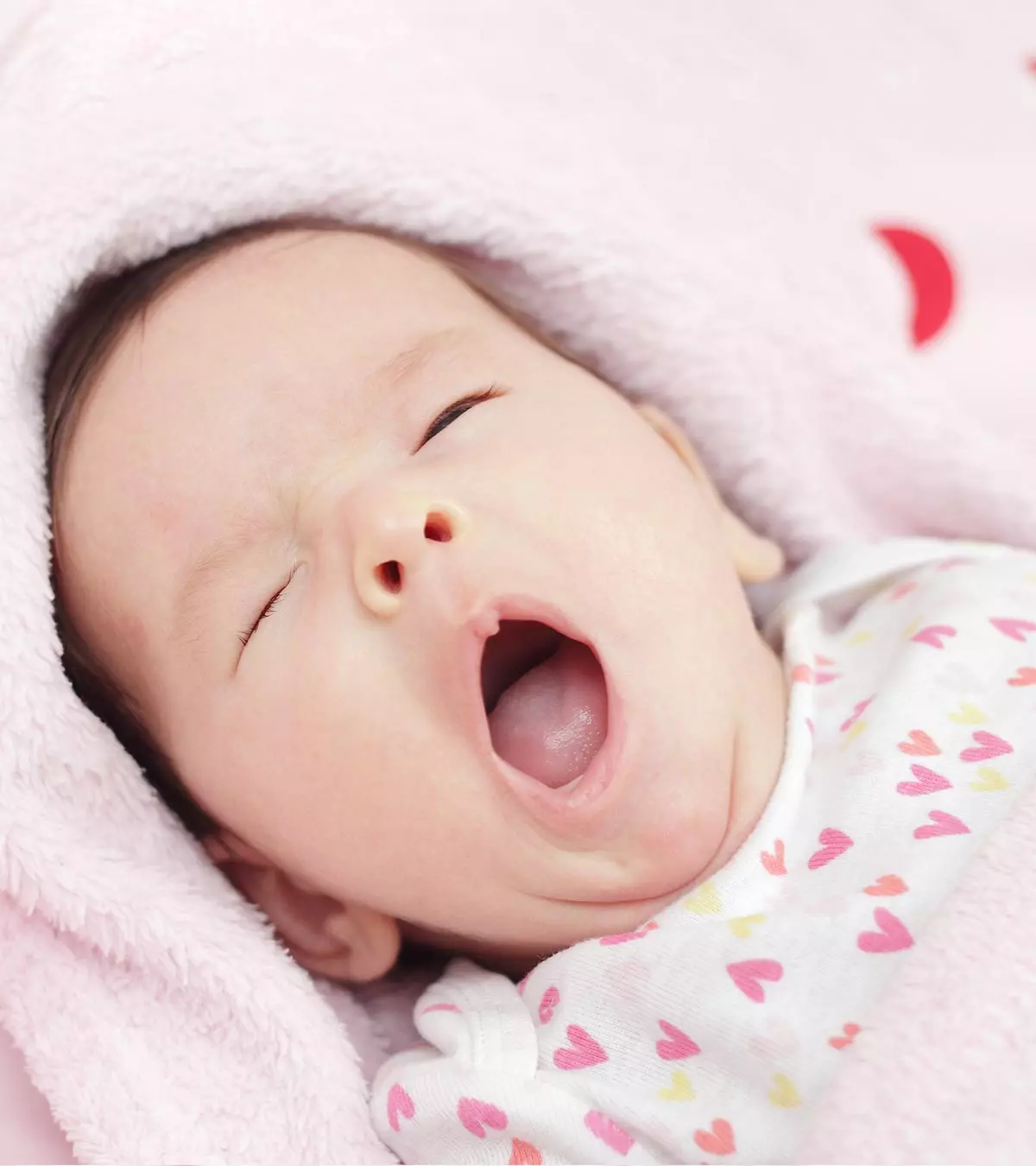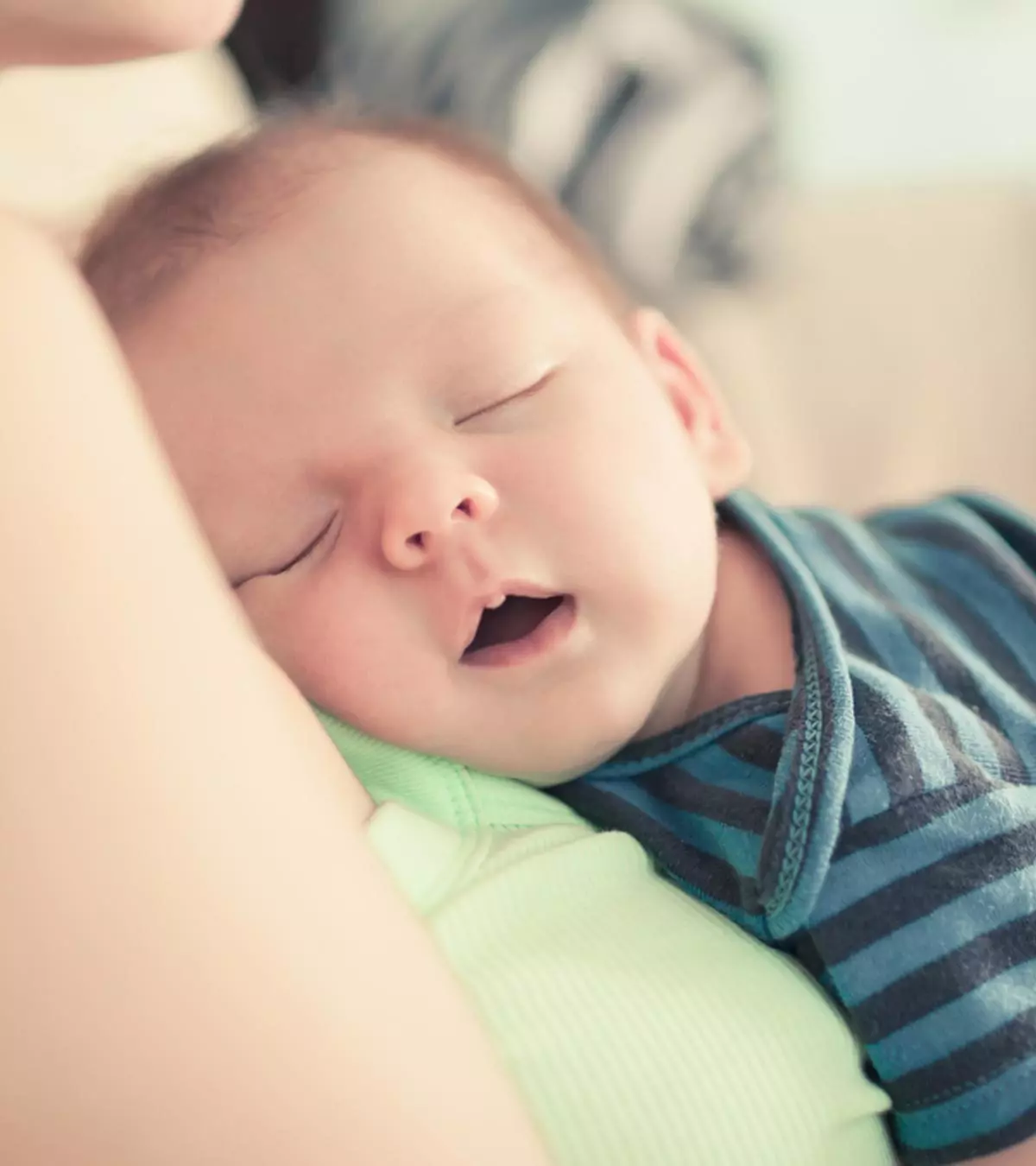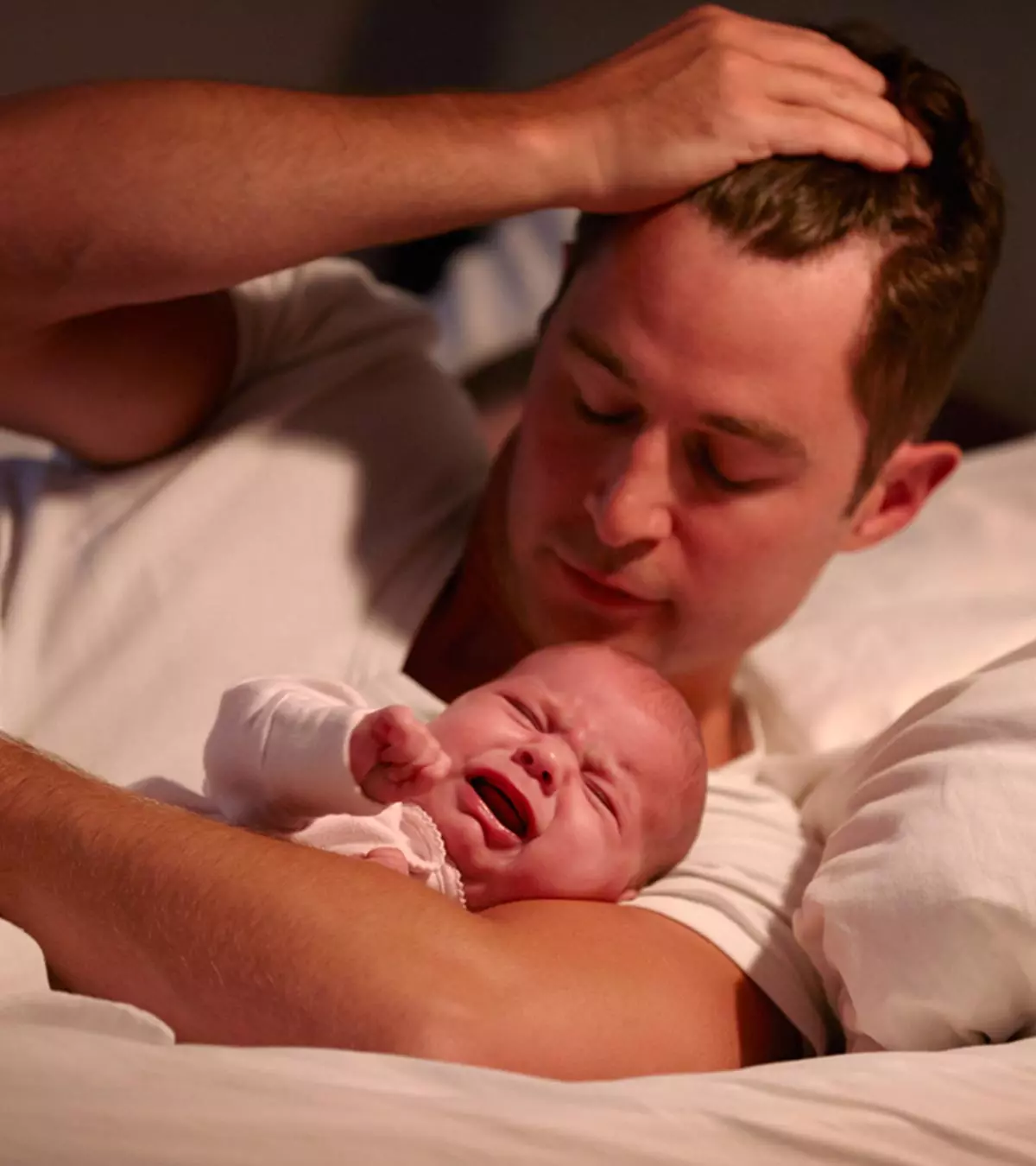
Image: Shutterstock
If you frequently discover your baby sleeping on the floor or if your baby enjoys spending time on the floor, you may wonder if napping on the floor is safe for your baby and if there are any potential benefits. Sleeping on the floor is a centuries-old custom still practiced in many cultures. However, you must take some measures if you want to let your baby sleep on the floor. This post discusses the answers to various concerns that you may have about your infant slumbering on the floor and provides some safety measures.

Key Pointers
- Babies can sleep on their back on firm surfaces after consulting a pediatrician.
- Sleeping on the floor allows for sleeping freely, preventing falls and accidental suffocation, and offers the freedom to get up by themselves.
- Clearing the floor and keeping electric cords and plugs tied away from the baby are a few precautions to observe.
Is Sleeping On The Floor Safe For Babies?
According to the Canadian Government safety standards, children under one year of age need to sleep on their backs on a firm surface (1). As the floor is a firm surface, you can make your baby sleep on the floor as long as you take all the necessary measures. However, talk to your pediatrician and take their opinion before making the decision.
Yes, letting your baby sleep on the ground means more baby-proofing and extra precautions, but it could all be worth it since the benefits of snoozing on the floor outweigh the risks. Are you wondering what these benefits could be? Read on.
 Quick fact
Quick factPotential Benefits Of The Baby Sleeping On The Floor
There are a few benefits of a baby sleeping on the floor. However, the ultimate decision to let your baby sleep on the floor depends on you and how your baby reacts to it. Also, it is best to talk to your pediatrician before opting for it. The following are a few benefits of a baby sleeping on the floor.
1. Sleep anytime, anywhere

If your baby likes to sleep on the ground, it is easy to get them to sleep anytime, anywhere. You need not carry expensive bedding or portable cribs. All you need is a simple blanket.
2. Get a good sleep
You can conveniently nurse the baby without the need to move them in and out of the crib or bassinet. This will help you keep those night feeds low-key and also give you a good night’s sleep. It may also allow you to have the space to co-sleep with your baby in the same room without the risks of accidental strangulation or suffocation (5) (6).
Sharing her experience with using a floor bed for the baby, Meyer, a mother and teacher, writes, “In an attempt to merge these two ideas, Daddy packed up Q-ball’s crib and put her crib mattress on the floor. Instant floor bed. Because the mattress is high (about 8 inches) we have placed pillows around the bed until Q-ball learns to control her nightly flips and turns. How’s it working? We love it! No injuries, and I believe we are upholding all of our parenting philosophies and values- even more so than we the crib!”
She adds, “We are still engaging in nighttime parenting because I still put Q-ball to sleep every night. Sometimes she nurses to sleep, but occasionally, I place her down on the mattress while she is drowsy and rub her back until she is asleep. I still respond instantly to her calls during the night. Additionally, on nights when she is pulling an all-niter, I have slept on my own floor bed (a sleeping mat for camping) next to her mattress for an hour or two. I then leave the room, and she sleeps much better for the rest of the night. This is an option that was not available with the crib, and it is making life better for everyone (especially Daddy who bore the brunt of the cranky family!) (i).”
3. Say goodbye to falling
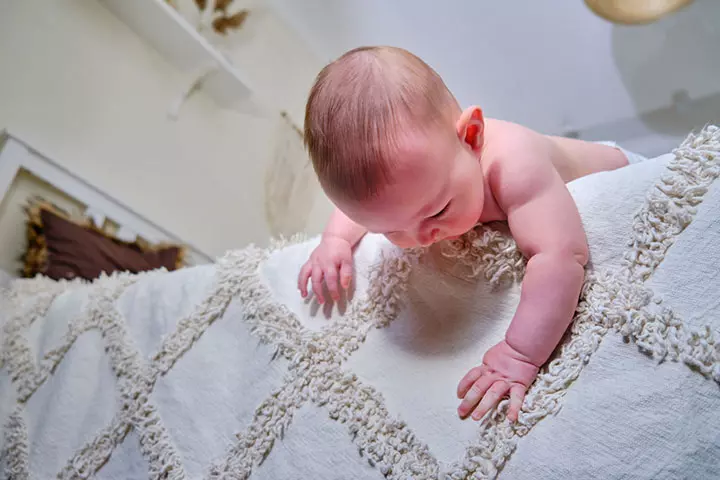
Unlike the crib or bassinet, the floor offers a large space for the baby to sleep freely. If your baby has the habit of rolling over while sleeping, the floor may be the best place for them to sleep, as there is no danger of them falling (7).
4. Prevent SIDS
In 2025, the Centers for Disease Control and Prevention reported approximately 1,389 mortalities attributed to sudden infant death syndromeiThe unexpected death of an infant under the age of one that can't be attributed to any particular cause (SIDS) (4). The floor is a firm and flat surface; thus, it is the recommended surface to prevent SIDS in infants (1).
5. Encourage independence
Sleeping on the floor not only averts the dangers of falling and suffocating, but also gives your baby the freedom to get up all by themselves, without your help. Sleeping on the floor allows your child to independently and confidently explore their surroundings. This allows them an opportunity to practice their newly acquired skills (7).
Anne, a mother from the mountains of Montanna, shares about her baby’s nursery setup. She writes, “Elise (her daughter) has been sleeping on her floor bed at night and for naps since she was twelve weeks old. Before that, she slept in a bassinet or with me on the couch. Having a floor bed has really worked out well for our family.” Sharing one of the many benefits of having a floor bed, Anne says, “Elise’s room is upstairs, and when she wakes up from a nap, we can hear her through the ceiling, crawling to either her shelf or her closet! She rarely wakes up crying – we end up going upstairs because we want to see her, not because she needs us (ii).”
6. Enjoy more bonding time

Sleeping on the floor is a perfect place for bed-sharing with your baby, as bed-sharing on the cot or crib is not recommended (7).
To let your baby reap the maximum benefits of sleeping on the floor, you need to make sure the environment is safe. The next section covers the safety precautions you need to take when your baby is sleeping on the floor.
Safety Measures To Take If Your Baby Is Sleeping On The Floor
It is important to take certain precautions to make the floor a suitable place for your baby to sleep. According to Nilong Vyas, a Louisiana-based board-certified pediatrician, and sleep consultant, “There are many benefits to a baby sleeping on the floor, but several precautions must be taken if that is to be the case. First, a baby must sleep on a flat, hard surface, which the floor provides, so an infant can start to sleep there as soon as a parent feels comfortable.
However, once the infant becomes more mobile (as early as 2-4 months of age), treat the room in which they will be sleeping on the floor as a giant crib. All items on the floor, outside of the mattress the infant may be on, must be out of reach of the infant. And especially once the infant starts to crawl, care must be taken so that wires, furniture, and toys are out of the child’s reach.”
Here are some important safety precautions to ensure that your baby sleeps safely on the floor:
- Make sure your baby sleeps on a roll-out bedding or a flat and firm mattress with well-fitted sheets. Avoid placing fluffy pillows or soft mattresses near the baby, as studies suggest that these could lead to suffocation (2).
- If you live in an area with a warm tropical climate, keep the room well-ventilated. Make sure you have a ceiling or hand fan to keep the baby from getting overheated. Also, do not dress your baby in tight-fitting clothes (5).
 Quick tip
Quick tip- Ensure to sweep and mop the floor every day to keep dust, mites, and insects away from the floor.
- Remove all small toys and sharp objects that can pose a risk for injuries or choking. Also, keep the room clear of stray threads, fairy lights, magnets, balloons, coins, batteries, plastic bags, styrofoam, and glitter (8).
- Do not place rugs, carpets, floor mats, beanbags, or cozy pillows near the baby, as this might lead to suffocation. Carpets and floor mats attract dust and fungus, which could cause allergies in babies (9).
- Baby-proof the room, place the baby in a safe spot on the floor, and make sure there are no floor-length drapes or curtains within reach of the child. Also, all electric cords and plugs should be neatly tied to prevent tangling (5) (2).
- Avoid placing the bedding near walls to prevent entrapment and injuries from rolling into the wall (5).
- Clear the area of items that can easily get knocked over during the night, especially if the space is limited or you are co-sleeping with the baby.
- If you live in a mosquito-prone area, ensure all the doors and windows are shut at dawn and dusk. If you wish to use electric coils or mosquito repellants, switch them off before the baby enters the room.
- Use chemical-free mosquito repellents and install mesh doors or screens on doors and windows. You can also use a customized baby mosquito net until the baby is old enough to roll over.

Frequently Asked Questions
1. Why does my baby sleep on the floor?
A baby might prefer to sleep on the floor for the comfort the surface might provide. They might prefer to sleep on the floor if their crib is uncomfortable. It could also be because it allows them to fall asleep in their favorite play spot.
2. When can a baby sleep in a floor bed?
Children under the age of one year need a hard surface to sleep upon. Hence, infants under that age may sleep on the floor bed.
3. Can I let my baby sleep on the playmat?
You may let your baby sleep on a playmat for a nap. Remove any toys that might hurt your baby from the playmat. Also, ensure you follow all the sleeping guidelines such as lying on the back and no blankets.
4. Does sleeping on the floor increase the risk of babies developing a flat head?
Vyas asserts, “The risk of their heads becoming flat in a crib versus on the floor is equal. I prefer to choose a place where the infant is allowed the safest sleeping environment.”
Baby sleeping on the floor is considered to be safe until and unless you ensure that the floor is clean and you maintain the necessary precautionary measures. There are several benefits of the baby sleeping on the floor, such as the reduced risk of SIDS, encouraging independence, and also reducing the risk of falling and hurting themselves. But you should make sure that the baby is sleeping on a flat mattress and there are no pillows around them to avoid suffocation. Consult the doctor once before making the final decision.
Infographic: Some More Benefits And Tips For Baby Sleeping On The Floor
Some babies find it convenient, while others prefer the floor to the bed; whatever the reason, it is fine to allow your little one to sleep on the floor, provided you take the necessary precautions. Check out this infographic to note the advantages and tips before letting your baby sleep on the floor.
Some thing wrong with infographic shortcode. please verify shortcode syntax
Illustration: Is It Okay To Let A Baby Sleep On The Floor? Pros And Cons
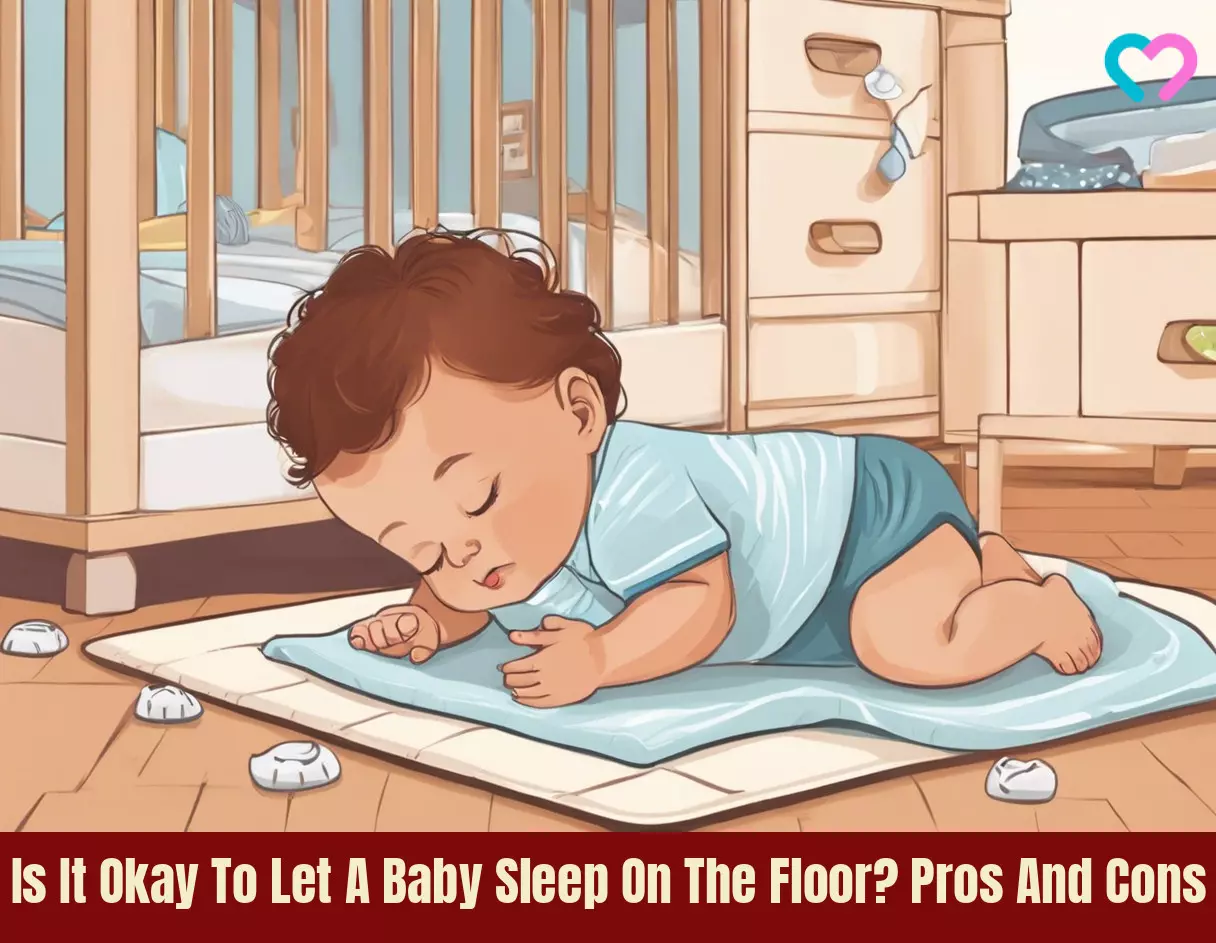
Image: Stable Diffusion/MomJunction Design Team
Personal Experience: Sources
MomJunction articles include first-hand experiences to provide you with better insights through real-life narratives. Here are the sources of personal accounts referenced in this article.
i. The Floor Bed: Merging AP and Montessorian Principles;
https://asecurebase.blogspot.com/2012/04/floor-bed-merging-ap-and-montessorian.html
ii. A little tour: e’s Montessori nursery;
https://ittybittylove.blogspot.com/2013/04/a-little-tour-es-montessori-nursery.html
References
1. Creating a safe sleep environment for your baby; Paediatrics Child Health (2004).
2. Roger W Byard and Calle Winskog; Floor mattresses: another potentially dangerous infant sleeping environment; Journal of Pediatrics and Child Health (2011).
3. Do Not Use Infant Sleep Positioners Due to the Risk of Suffocation; USFDA
4. Sudden Unexpected Infant Death and Sudden Infant Death Syndrome; Centers for Disease Control and Prevention
5. Let’s talk about floor beds; Little Sparklers Ltd
6. What Are the Benefits of Floor Beds?; Boco Strong
7. Montessori Floor Bed; Creating Compassionate Kids
8. Infant environments: Let’s take a closer look; The Pennsylvania State University
Community Experiences
Join the conversation and become a part of our nurturing community! Share your stories, experiences, and insights to connect with fellow parents.
Read full bio of Dr. Elna Gibson
- Dr. Nilong Vyas is a pediatrician, public health specialist, and board-certified sleep expert. She did her MD and Pediatrics Residency Program at Louisiana State University School of Medicine in New Orleans and Master of Public Health in epidemiology at Tulane University School of Public Health and Tropical Medicine. She has 15 years of experience as a pediatrician and sleep expert.
 Dr. Nilong Vyas is a pediatrician, public health specialist, and board-certified sleep expert. She did her MD and Pediatrics Residency Program at Louisiana State University School of Medicine in New Orleans and Master of Public Health in epidemiology at Tulane University School of Public Health and Tropical Medicine. She has 15 years of experience as a pediatrician and sleep expert.
Dr. Nilong Vyas is a pediatrician, public health specialist, and board-certified sleep expert. She did her MD and Pediatrics Residency Program at Louisiana State University School of Medicine in New Orleans and Master of Public Health in epidemiology at Tulane University School of Public Health and Tropical Medicine. She has 15 years of experience as a pediatrician and sleep expert.
Read full bio of Rohit Garoo
Read full bio of Dr. Ritika Shah
Read full bio of Vidya Tadapatri





